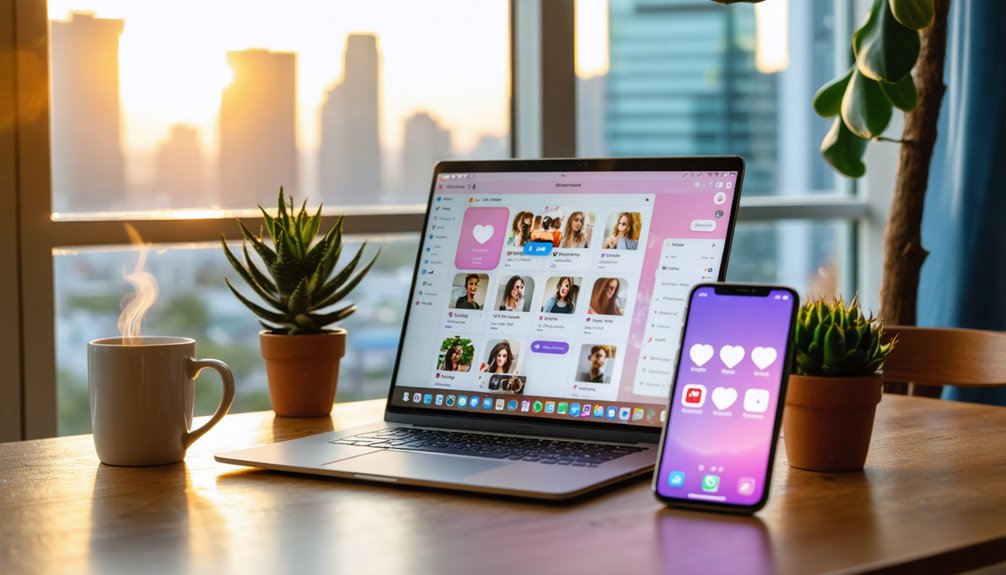What Is Online Dating? How It Works and Why It’s So Popular

We’re living in a moment where dating is part app, part algorithm, and all about intent. We create profiles, signal interest, and let behavioral data surface matches faster than any bar intro could. Filters narrow the field; prompts and video vet chemistry; safety tools and verification shape trust. It works because it compresses the meet-cute into measurable steps—and it’s soaring in adoption. But the real shift isn’t the tech; it’s how we use it next.
Defining Online Dating in Today’s Digital Landscape

While the apps evolve by the quarter, online dating today simply means using digital platforms—mobile apps, websites, and social features—to discover, vet, and connect with potential partners at scale. We treat it like a social utility: profiles, prompts, DMs, and video become digital rituals that set expectations fast. We segment by intent and identity, tapping niche communities where shared values and micro-interests improve match quality. We filter with location, lifestyle, and safety tools, then move conversations cross-platform. Success looks like conversion: quality chats, timely meets, fewer mismatches. It’s not passive browsing—it’s a streamlined, data-informed way to meet people efficiently.
The Evolution From Matchmaking to Apps and Algorithms

We’ve watched dating move from quirky classifieds and community boards to sleek web portals, then into our pockets. Now, apps optimize swipes with algorithm-driven matching that uses behavioral signals, geolocation, and machine learning. Let’s unpack how that shift changed discovery, conversion, and what “compatibility” really means today.
From Classifieds to Sites
Kicking off the digital love story, we trace how personal ads in newspaper classifieds morphed into niche sites, and then surged into swipe-led apps powered by algorithms. We remember when Print classifieds quietly seeded intent: short blurbs, coded phrases, local reach. Then dot‑com matchmaking professionalized search, profiles, and safety cues. Niche communities exploded—faith-based, LGBTQ+, gamers—turning broad markets into targeted microcultures. We followed user behavior: photos improved, messaging normalized, and verification tools matured. As mobile reshaped discovery, sites optimized funnels and monetization. Today, legacy platforms still convert, especially for serious daters, while new entrants iterate formats, events, and brand partnerships to stay sticky.
Algorithm-Driven Matching
From swipes to embeddings, algorithmic matching now runs the dating market’s engine. We’ve shifted from profiles to prediction: platforms mine behavioral data—likes, pauses, replies—to train machine learning models that rank compatibility in real time. As apps chase retention and safety, we watch A/B tests adjust visibility, prompts, and vibes to optimize outcomes. The playbook’s clear: signals in, scores out, feedback loops refine.
| Signal Type | Model Use | User Impact |
|---|---|---|
| Swipe tempo | Interest inference | Better candidate pacing |
| Message depth | Affinity scoring | Higher-quality matches |
| Location drift | Context modeling | Timely suggestions |
| Report patterns | Risk detection | Safer experiences |
Setting Up a Profile That Reflects You

Cutting through the noise, we’re building a profile that signals who we are now—not last year’s vibe. We lead with Authentic photos: clear daylight shots, zero heavy filters, a candid laugh, a full-body frame. We rotate images when our look changes; trends move, profiles should too. Next, we script Voice prompts with intention—20 seconds that show cadence, humor, and values. We keep bios punchy: one mission line, three specifics, one current obsession. We credit hobbies with receipts—playlist links, book stacks, race bibs. We adjust privacy settings, prune stale details, and align prompts with real life. Consistency converts attention into conversation.
Matching Mechanics: Filters, Swipes, and Compatibility Scores
We’ve got the profile tight; now the algorithm wants signals it can actually use. We set filters—age, distance, interests—to shape the feed, but platforms add Ghost filters that quietly steer who sees us. Swipes fuel real-time ranking; fast rights boost visibility, indecision buries us. Behind the scenes, constant A/B testing tweaks card order, prompts, even pause timing to lift match rates. Compatibility scores blend stated prefs with behavioral twins: who we linger on, skip, or revisit. We calibrate, then recalibrate—narrow to improve intent, widen to surface serendipity. The game isn’t random; it’s data loops optimizing attraction economics.
Messaging Etiquette and Building Connection Online
Usually the first message decides whether a chat lives or dies, and today’s apps telegraph it with prompts, voice notes, and read-receipt nudges. We open with something specific—referencing a bio detail or recent story—then keep momentum with tight replies. We practice tone matching: mirror their energy, emoji style, and cadence without parody. We watch humor pacing; one joke lands, three feel try-hard. We alternate questions and micro-stories to reveal substance, not interrogate. We shift to voice notes or a short call when rapport clicks, signaling intent. We close loops, propose a next step, and respect response rhythms.
Safety, Privacy, and Red Flags to Watch
Even as apps roll out selfie verification, AI scam filters, and background-check add‑ons, we treat safety as a workflow, not a feature. We audit privacy settings, limit profile breadcrumbs, and watch for scam indicators: rushed intimacy, crypto pitches, gift-card asks, or odd payment routes. We check metadata tells—new accounts, recycled photos, and location spoofing. We spot emotional manipulation: love-bombing, guilt, urgency, or fake emergencies. We verify identities with cross-platform traces and time-stamped content. We compartmentalize: separate handles, masked numbers, minimal geotags. We screenshot receipts of chats. If something feels off, we pause, block, report, and move on.
From Chat to First Date: Moving Offline With Confidence
As apps push for “intent labels” and video pre-dates, we set clear expectations early so no one wastes time. We’ll translate that clarity into logistics: public venues, shared ETAs, and a tight first-meet window that keeps control on our side. Let’s outline the playbook we use—what we say, how we vet, and the simple safety checks that make moving offline feel easy.
Setting Clear Intentions
While chat threads can stretch for weeks, momentum builds when we set clear intentions early. We’re seeing a shift across major apps: direct, time-bound asks outperform endless banter. Let’s state what we want—casual coffee, a video intro, or exploring exclusivity—and define communication boundaries upfront (response cadence, preferred channels). We can share relationship timelines without pressure: Are we dating to explore, or aiming for commitment by quarter’s end? Clear stakes cut ghosting risk and align expectations. We should propose a window for moving offline and agree on pace. Intentionality signals respect, filters mismatches fast, and keeps promising connections on track.
Planning Safe Meetups
From DM to door, we treat the first meetup like a product launch: plan, verify, and de-risk. We pick a busy public space with cameras and staff, then confirm identities via quick video and photo checkpoints. We share expectations, timelines, and exit options. We loop in a friend with location sharing and timed check ins, like a live ops dashboard.
- Meet where the crowd and lighting favor visibility; arrive separately; control transit.
- Lock a check-in cadence, plus a code word if vibes shift.
- Cap the first date: one drink, one hour, one follow-up.
Safety scales trust without killing chemistry.
Why It’s So Popular: Convenience, Choice, and Outcomes
Let’s cut to it: online dating wins because it compresses time, expands options, and delivers measurable results. We swipe between meetings, match on lunch breaks, and keep momentum thanks to mobile convenience. Choice scales fast: filters, prompts, and discovery feed algorithms surface compatible people we’d never meet offline. Add virtual communities, and we’re not just dating—we’re joining micro-networks shaped by interests and values.
Outcomes are trackable. We see read receipts, response rates, and match-to-date conversion. Platforms iterate weekly, optimizing intros and safety tools. The trendline’s clear: more efficient search, smarter signals, and better fits. That’s why adoption climbs—and satisfaction follows.
Conclusion
As we navigate a dating landscape shaped by algorithms, safety features, and shifting norms, online dating isn’t just mainstream—it’s the market standard. We build profiles with intent, filter with precision, and convert chats into meetups faster than ever. With new verification tools, AI-assisted prompts, and niche communities scaling, we’re seeing better matches and clearer signals. If we stay savvy—protect privacy, spot red flags, and move offline thoughtfully—we can leverage the trend and date smarter, not harder.
